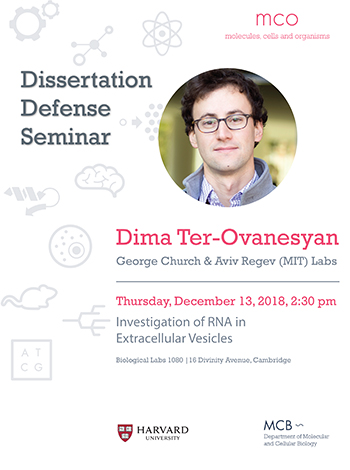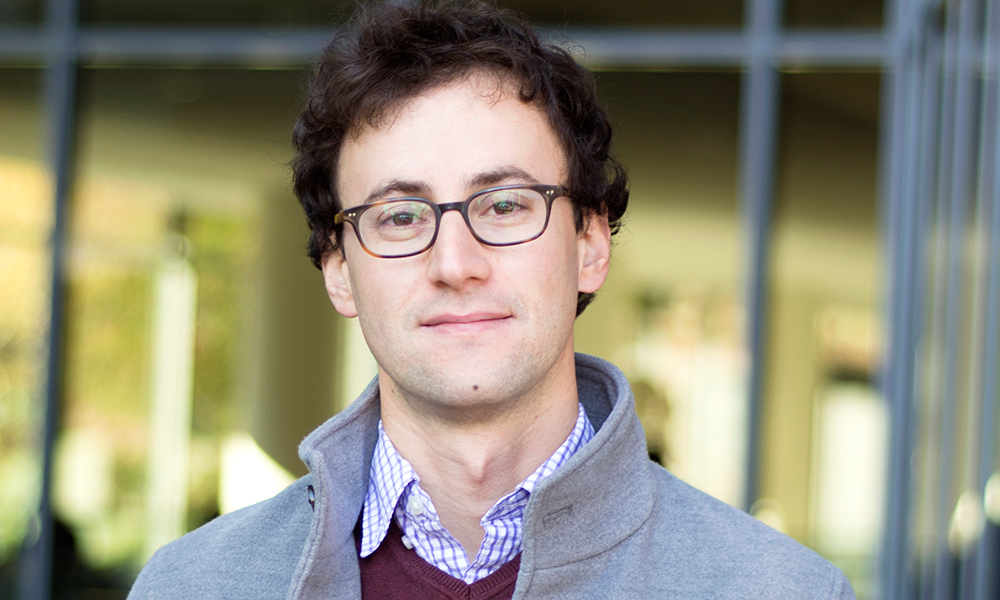Dima Ter-Ovanesyan had been up all night working as a student-EMT, but he went to the lab the next morning to conduct his experiment. He soon found that labwork and hectic nights full of emergency calls don’t mix well.
“I was so sleep-deprived that instead of opening the ice machine, I opened the eye wash, which had a similar handle. And it just sprayed me in the face with water,” Ter-Ovanesyan says. “That’s when I realized that I should pick [just] one career.”
He chose research, but Ter-Ovanesyan’s work as an MCO grad student could aid new medical diagnostics. He studies a phenomenon called extracellular vesicles. They form when pieces of cell membrane bud off and drift away from the cell. These vesicles—also known as exosomes—often carry bits of RNA or proteins inside them. Because the vesicles end up in the bloodstream, researchers and clinicians can sample them with blood tests. They could offer a glimpse into inaccessible tissues like the heart and the brain.
The problem is that researchers don’t know much about extracellular vesicles. But for Ter-Ovanesyan, that’s part of the appeal.
Faculty have taken notice of Ter-Ovanesyan’s curiosity. “Dima is the exemplar of the mixture of romantic passion and willingness to bend your ideas to face experimental facts that defines good science,” says MCB professor Andrew Murray, who is on Ter-Ovanesyan’s thesis committee.
Ter-Ovanesyan’s path into scientific research involved a lot of globe-trotting. He was born in Soviet Ukraine to a physicist father and a chemist mother. His family soon left for Israel, where his father studied physics as a grad student at the Weizmann Institute. When Ter-Ovanesyan was seven, the family moved to the US. After three years in Santa Barbara and another three in Cincinnati, the family finally ended up in Boston. After high school, he attended college just across the river at MIT. “My dad just dropped me off to college on his way to work,” he recalls.
One topic that caught Ter-Ovanesyan’s attention in undergrad was microRNA. “Just when we thought we really understood how gene expression worked, there was actually a whole layer more in the form of these small pieces of RNA that controlled protein expression that no one knew about,” Ter-Ovanesyan says.
MicroRNAs eventually led him to exosomes. One night while catching up on the literature, Ter-Ovanesyan read a line in a paper about RNA wrapped in extracellular vesicles traveling through the bloodstream. He hadn’t heard about exosomes before but instantly wanted to know more.
“There wasn’t anyone working on anything like this at MIT,” he recalls. “So I decided that I would take time off to learn more about this field.”
After graduating, he set off for Paris, where he spent a few months working in one of the very few exosome-focused labs, Clotilde Théry’s lab at The Institut Curie. Then he spent a year working with researcher Johan Skog at a startup called Exosome Diagnostics, a company that develops cancer diagnostics based on biomarkers found in exosomes.
Ter-Ovanesyan soon headed to grad school to investigate exosomes’ basic biology. There are no labs at Harvard MCB that specialize in extracellular vesicles, so he joined George Church’s lab at the medical school. “George is very open to new ideas and gives people a huge amount of freedom,” Ter-Ovanesyan says. ”He basically lets people work on whatever they want, which at the time seemed very enticing.”
He also added Aviv Regev of the Broad Institute as a co-advisor because of her expertise in RNA biology and computation.
However, Ter-Ovanesyan’s research path hasn’t always followed straight lines. “He came to Harvard determined to work on the idea that cells package specific RNA molecules to send to other cells as messages, did painstakingly careful experiments, and came to the conclusion that the packages simply contain a random sample of a cell’s RNA molecules,” Professor Murray recalls. “Science depends on people like Dima who are willing to take the time and energy to prove their initial ideas wrong…Each time they do so, we know a little bit more about how the world works.”
Though the RNA transfer experiments didn’t pan out, Ter-Ovanesyan’s concurrent work characterizing the RNA in exosomes turned out to have potential medical relevance. “All cells release [exosomes], but we have no idea why,” he says. Exosomes from any tissue can end up in the blood. Fortunately, many of these vesicles carry distinctive proteins that mark them as coming from particular cell type. Ter-Ovanesyan has been working on assays that “catch” the exosomes carrying the target proteins.
When he’s not in the research lab, Ter-Ovanesyan often contributes to outreach initiatives such as Science in the News (SITN), which organizes free public lectures for lay audiences, and summer science programs for high schoolers. Last summer, he flew to Poland to lead a group of high school student researchers at the School of Molecular and Theoretical Biology. “You basically teach the kids how to work in a lab but through a real research problem, as opposed to just teaching them to do PCR just for the sake of it,” Ter-Ovanesyan says. “Choosing a research question is difficult, because it has to be a real research question, but it has to be manageable for them.”
He asked the high school students to try killing the cells many different ways, and then they collected the DNA released by dying cells for analysis. Methods of cellular execution included freezing, frying, drowning the cells in ethanol, and poisoning with drugs. “Sometimes they would accidentally kill the cells…[but] we could add that to the list of experimental conditions,” Ter-Ovanesyan says.
He has also worked as a teaching fellow during five different semesters, going well beyond MCO’s required two semesters.
After nearly eight years working on his thesis, Ter-Ovanesyan will complete his Ph.D. this fall. He’ll stay on at the Wyss Institute branch of the Church Lab and continue his basic research. However, the exosome isolation techniques he’s developing will be used in a study of gene expression changes in neurons affected by Parkinson’s.
“The use of exosomes diagnostically is limited by our lack of understanding of their biology,” he explains. “I wasn’t planning on working on developing diagnostics when I started grad school, but, when I realized that some of my findings unexpectedly had some diagnostic applications, I decided to go for it.”
by Diana Crow




